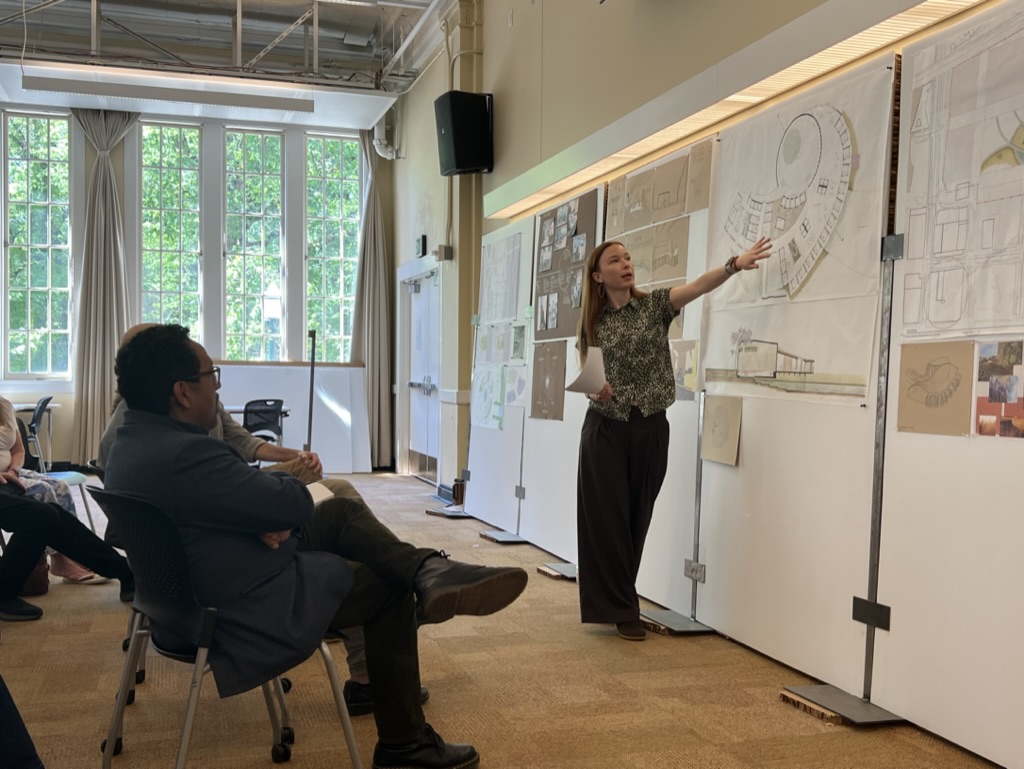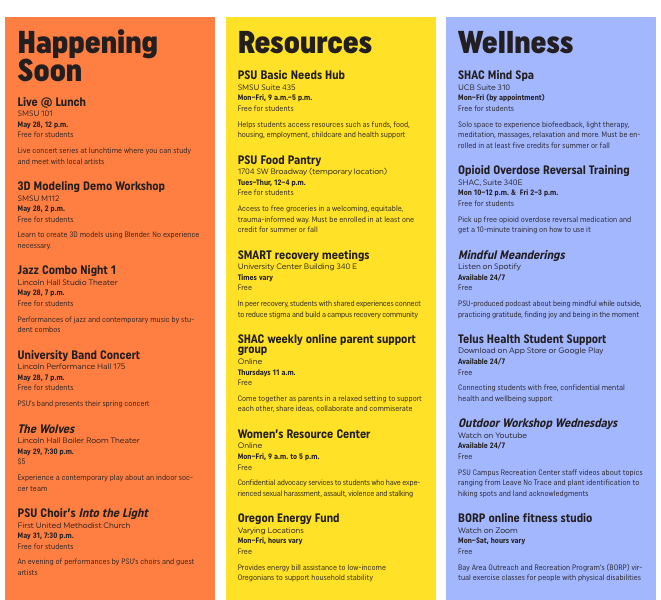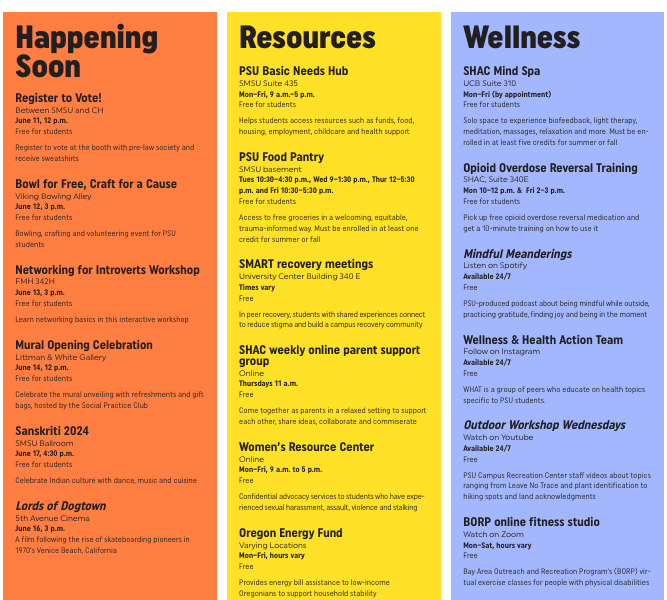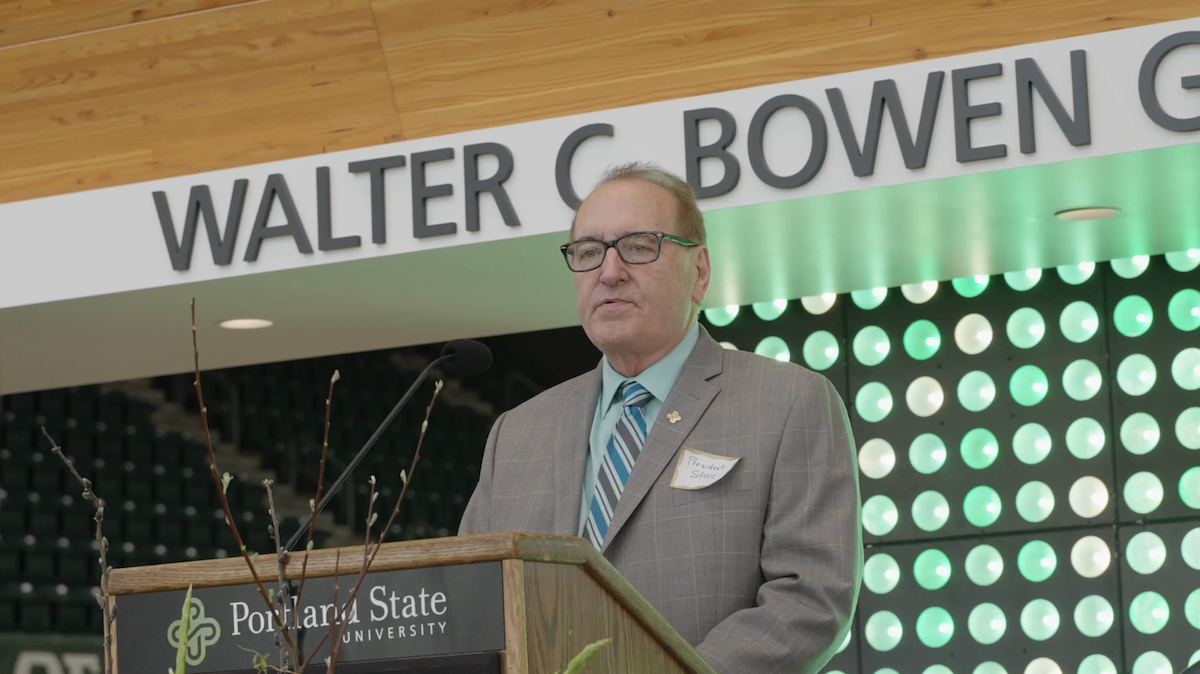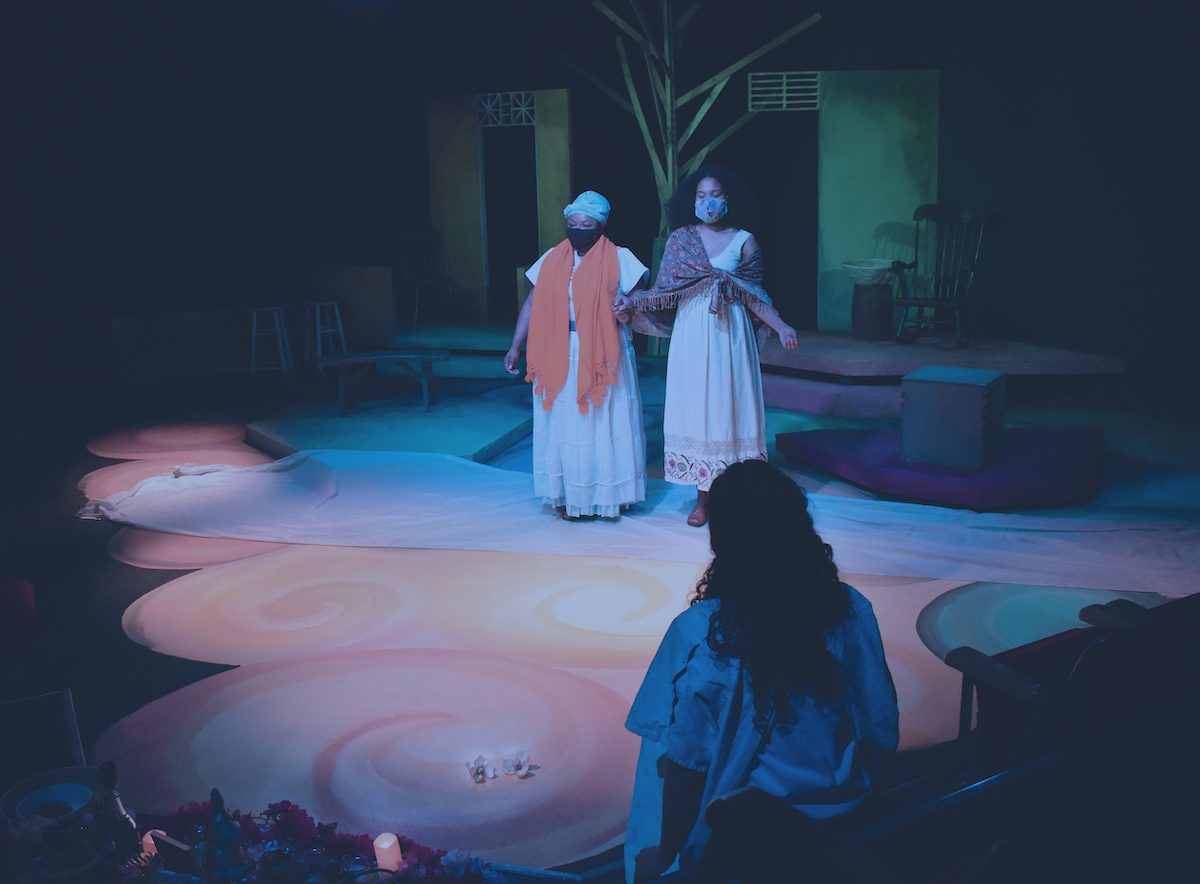Graduate students in the Master of Architecture (M.Arch) program at Portland State are finalizing their capstone thesis projects. Each member of the 18-student cohort has designed a thesis project guided by an overarching question corresponding to a particular place or community.
“They can be situated more in theory or more in practice, depending on what you want to do,” said M.Arch student Kaleb Huerta. “So some people will get extremely theoretical and philosophical about what it is, and some of them will be much more rooted in the zoning and planning and all the regulatory things that determine what we can and can’t do.”
“A lot of it is self guided,” Huerta said. “So you’re set up with the tools to start framing what you’re thinking about, but what it actually becomes is up to you.”
These thesis projects involve extensive research, community outreach, urban design planning, model-making, sketchwork, mapmaking and other modes of craftwork. Each thesis will culminate in a printed book, oral presentations and an open-house gallery display.
“We are, in a thesis, developing both the problem and the solution, and so a lot of it is telling a story through the process,” said M.Arch student Eric Giovannetti.
For M.Arch student Zeta Blice, housing insecurity in Portland was the problem to be addressed. Blice’s thesis question asked, “How can architecture join education and housing to create a safe environment for unhoused students and their families?” This thesis project repurposes the abandoned sheriff’s office on 122nd Avenue and Gleason Street to be used as a middle school and affordable living space.
M.Arch student Brandi Barlow’s thesis seeks to “rebridge the connection between the medical world and the natural world, and to integrate spiritually engaging spaces to further support and humanize patients.” Barlow’s inspiration has come from witnessing their own mother’s journey in cancer treatment and recognizing the positive effects of more natural, welcoming settings rather than clinical environments.
“I think, for a lot of us, [our theses have] something to do with our heart, in a way…” said M.Arch student Athena Rilatos. “You follow that thread of what is your passion, or what is something that’s exciting for you to work on, and then you’re just spending your time getting to work on that.”
Informed by Indigenous Futurism, Rilatos’s thesis project is guided by the question, “how can architecture facilitate Indigenous restoration in the urban environment?” This project realizes Land Back by restoring waterways and their previously buried or disrupted natural ecosystems and “integrating Indigenous treaty rights to fish, hunt and gather into downtown Portland’s landscape,” Rilatos said.
“As a Native, in my treaties it’s stated that I have the right to fish, hunt and gather,” Rilatos said. “And we are people of roots, fish and game. And it’s really hard to find that within the urban context. So I have to be Native out there, not in the city.”
Rilatos’s thesis prioritizes sustainable development and honors the cultural preservation and rights of local Indigenous peoples while also providing the Portland area with greater access to the region’s natural beauty and wildlife.
Decolonizing Portland is also the focus of M.Arch student Rebecca Silk’s thesis project. Silk’s main priority in developing their thesis was to “connect people with plants and the environment.”
Silk chose the abandoned United States Postal Service site in NW Portland near Broadway Bridge as the site for their thesis project. The area will be redeveloped into a park featuring a basketry learning center. The land will use “Native American tending practices, to encourage reciprocal relationships [in which] humans care for the plants and plants care for the human,” Silk said.
Another M.Arch student, Alondra Maldonado, has centered her thesis on the Latino community of Rockwood, Oregon. “Growing up in this area, I have always noticed a deep need for the introduction of third spaces—places for leisure, learning, resources and more,” Maldonado said.
Maldonado titled the project “Fortaleza.” The project seeks to answer the question, “How can architecture and urban design strategies be employed to foster vibrancy, resiliency, and prosperity within the Latino community in Rockwood, Oregon?”
This project bolsters community resources in Rockwood while honoring the city’s cultural identity. Maldonado has redesigned several blocks in the city center, incorporating an indoor soccer arena, a church, a music event center, affordable housing units and a pulga—or flea market—among other resources.
Maldonado’s research process involved significant community engagement. She spoke with business owners, clientele at her mother’s store, pulga vendors and other Rockwood community members to find out “what is missing in the United States that they left behind in their country, and bringing that little piece of home here, because I think everyone deserves a space to be in,” Maldonado said.
M.Arch student Brianna Montes also draws from personal experience in a Mexican-American community to form a thesis project which reimagines the U.S.−Mexico border.
Montes’ project is located between Brownsville, Texas and Matamoros, Tamaulipas. It is guided by the question, “How can replacing the U.S.-Mexico border with activity notes contribute to the realization of a 15-minute city model and promote transcultural experiences for those living along the border?”
Montes defines activity nodes as public spaces which bring people in, such as playgrounds, libraries, green spaces or even outdoor seating. This thesis project merges the two cities by introducing various activity nodes while ensuring all necessary goods and services are within a 15-minute radius—on foot or bike—at any given point across both cities.
At the heart of this thesis project is a community hub and shopping center called Mercado Plaza which conjoins the two cities. “This will serve as an open public space for both communities to come together and to begin to strengthen the existing trans-cultural way of living,” Montes said.
This project confronts the physical, social and cultural harm perpetuated by the current functioning of the U.S.−Mexico border. As a native of this region, “home itself is what inspired me to start this thesis,” Montes said.
Huerta and M.Arch student Ethan Goldblatt have collaborated on a joint thesis project which also transforms home—in this case, downtown Portland—into a thriving city center. “I think public space in Portland is just not really as activated and interesting as it could be,” Huerta said, pointing out many vacant buildings, unprogrammed spaces and hostile architecture around the city.
The site of Huerta and Goldblatt’s thesis project starts from Pioneer Square and leads down SW Yamhill Street to Tom McCall waterfront. The project incorporates a green corridor which would create a covered, walkable path from Pioneer Square to the waterfront.
The waterfront would be transformed into a beach access point supporting water activities, such as swimming and kayaking. The project includes additional waterfront infrastructure, such as restaurants and cafes, outdoor auditorium-style seating and a water taxi transporting people down and across the river.
The project challenges the notion that the Willamette River is unclean or unsafe. “People have it in their head of it as like an industrial river, but they’ve done a lot to try to [improve that],” Huerta said. “And so swimming is a big part of that… getting people’s toes in the water is a really big thing, to be able to connect to the river and start establishing that space as a swimming space.”
This thesis prioritizes public transportation and walkable spaces over car roadways to build a stronger connection between the city and the river. “We’re looking at the streets becoming a little more of a space for people versus just car space and starting to break down the barrier that is Naito [Parkway],” Huerta said.
Huerta and Goldblatt’s project drew inspiration from their shared experience on a recent travel grant where they studied architecture abroad in Singapore and Taiwan. The duo decided on these destinations in light of the countries’ unique and inverse approaches to urban design.
Huerta explained that Singapore is known for its master city planning, developing the urban landscape with an orientation towards the far future. Meanwhile, in Taiwan there is “a very long history of organic urbanism where things sprout up and emerge and are allowed to be there,” Huerta said.
The research which Huerta and Goldblatt engaged in abroad ultimately carried over into their thesis project. “We’re trying to figure out what of these two different approaches is potentially something that can be drawn on for Portland, or more generally anywhere,” Huerta said.
An open house event displaying the M.Arch student thesis projects will be held on June 13 in Shattuck Hall.

